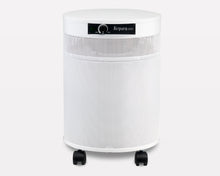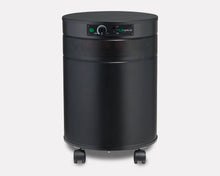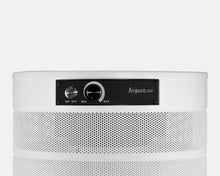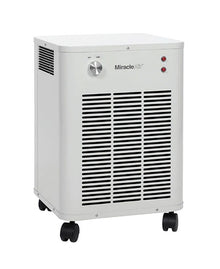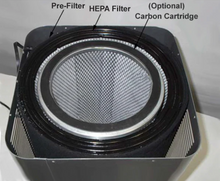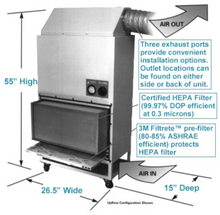Choosing the Right Size Commercial Grade Air Purifier for Your Home: A Complete Sizing Guide

Published: August 12th, 2025
When you walk into your home after a long day, the last thing you want to worry about is whether the air you're breathing is truly clean. Yet with indoor air often containing pollutants at levels 2-5 times higher than outdoor air, choosing the right air purification system isn't just about comfort—it's about protecting your family's health. Commercial grade air purifiers offer powerful solutions for home use, but selecting the wrong size can leave you with inadequate air cleaning or unnecessary energy costs.
This comprehensive guide will help you navigate the complex world of commercial air purifier sizing, ensuring you make an informed decision that delivers the clean air your home deserves.
Understanding the Commercial Grade Advantage in Residential Settings
The distinction between consumer and commercial grade air purifiers extends far beyond simple marketing labels. Commercial units are engineered to handle larger volumes of air, operate continuously under demanding conditions, and maintain consistent performance over extended periods. Commercial air purifiers are devices designed to clean the air in large spaces by using highly efficient filters that capture harmful particles from the air, which are then removed, allowing the system to recirculate clean, fresh air back into the environment.
For homeowners, this translates to several key advantages. First, commercial grade units typically feature more robust motors and fan systems that can move larger volumes of air more efficiently. Second, they often incorporate multiple filtration stages, including pre-filters, HEPA filters, and activated carbon layers that work together to address a broader spectrum of contaminants. Third, these systems are built to operate continuously without the wear and tear concerns that might affect consumer units.
The growing popularity of commercial grade air purifiers in residential settings reflects changing consumer awareness about indoor air quality. Recent market analysis shows that the U.S. air purifier market will witness shipments reaching 8.91 million units by 2029, with the COVID-19 pandemic significantly fueling increased demand for air purifiers. This surge has driven more homeowners to consider commercial grade solutions for their superior performance and reliability.
The Science Behind Proper Air Purifier Sizing
Understanding how air purifier sizing works requires grasping the concept of Clean Air Delivery Rate (CADR), the industry standard for measuring an air purifier's effectiveness. CADR represents the volume of clean air an air purifier can deliver in a specific time period, typically measured in cubic feet per minute (CFM) for the American market.
The relationship between CADR and room size follows established formulas that account for air changes per hour. To calculate proper sizing, you need to multiply the volume of the space by 3, as most spaces should aim to have all the air in the room cleaned three times per hour. This means for a 12-foot by 15-foot room with 8-foot ceilings (1,440 cubic feet), you would need an air purifier with a CADR of approximately 4,320 CFM to achieve three air changes per hour.
However, the calculation becomes more nuanced when considering different pollutant types. For wildfire smoke, AHAM recommends a Smoke CADR equal to the size of the room in square feet, while using an air cleaner with a higher CADR will simply clean the air more often and faster. This highlights why commercial grade units, with their higher CADR ratings, provide more versatile solutions for varying air quality challenges.
The EPA provides additional guidance for virus removal, noting that for an air cleaner to be effective in removing viruses from the air, it must be able to remove small airborne particles in the size range of 0.1-1 micrometer. Commercial grade HEPA filters excel in this range, making them particularly valuable for health-conscious homeowners.
Here's a simple CFM calculator you can use to determine what size unit you should purchase.
Calculating Your Home's Air Purification Needs
Determining the right size commercial air purifier for your home involves more than simply matching CADR to square footage. Several factors influence the calculation, starting with accurate room measurements. Begin by calculating the volume of each space you want to purify: length × width × height = cubic feet.
CADR is measured based upon a standard 8-foot ceiling, so if your ceilings are higher, you will need to make modifications to account for the extra square footage. For rooms with 10-foot ceilings, multiply your floor area by 1.25 when calculating air purifier requirements. For 12-foot ceilings, use a multiplier of 1.5.
Beyond basic dimensions, consider your home's specific air quality challenges. Homes with pets, smokers, or family members with allergies or asthma require higher air change rates. Similarly, homes in areas with high pollen counts, wildfire risk, or urban pollution may benefit from oversizing their air purification systems.
A practical approach involves using the 2/3 rule as a starting point: take your room size in square feet and multiply that by 2/3 to determine minimum CADR requirements. However, for optimal performance, especially with commercial grade units capable of higher air flow rates, consider targeting CADR ratings that equal or exceed your room's square footage.
For multi-room applications, you have two primary options: installing a central air purification system that integrates with your HVAC, or using strategically placed portable commercial units. Central systems offer the advantage of whole-home purification but require professional installation and may not address varying contamination levels in different rooms. Portable commercial units provide flexibility to concentrate purification power where it's needed most.
Key Factors That Influence Air Purifier Size Requirements
Several environmental and lifestyle factors significantly impact your air purifier sizing needs beyond basic room dimensions. Understanding these variables helps ensure you select a system that performs effectively under your specific conditions.
Air circulation patterns in your home play a crucial role in purifier effectiveness. Open floor plans with good natural air circulation may allow a properly sized unit to effectively clean a larger area than the calculated room size suggests. Conversely, rooms with poor air circulation, multiple doorways, or frequent door openings may require larger capacity units to maintain consistent air quality.
Pollution sources within your home dramatically affect sizing requirements. Cooking activities, especially frying or grilling, generate particles and odors that can overwhelm undersized purifiers. Pet dander doesn't just affect the room where pets spend time—it circulates throughout the home via HVAC systems and natural air movement. Smoking, fireplace use, and even certain cleaning products create contamination loads that require enhanced purification capacity.
External pollution sources also matter. Homes near busy roads, industrial areas, or regions prone to wildfire smoke face higher baseline contamination levels. During high pollution events, even properly sized units may struggle to maintain optimal indoor air quality without adequate capacity reserves.
The number of occupants affects both particle generation and required air quality standards. More people means more skin cells, hair, and respiratory particles, plus potentially more activity that stirs up settled dust and allergens. Homes with elderly residents, young children, or individuals with respiratory conditions may benefit from oversized air purification systems that maintain consistently high air quality.
Commercial Grade Features That Impact Home Use
Commercial air purifiers bring several advanced features to residential applications that affect sizing and performance considerations. Understanding these features helps homeowners make informed decisions about capacity and placement.
Multi-stage filtration systems in commercial units typically include pre-filters that capture larger particles, extending the life of more expensive HEPA filters. This design allows commercial units to handle higher particle loads without frequent filter replacements, making them cost-effective for homes with significant contamination sources.
Variable speed controls found in commercial units allow users to adjust air flow rates based on current conditions. During normal conditions, you might run the unit at lower speeds for quiet operation and energy efficiency. When cooking, cleaning, or dealing with outdoor pollution events, you can increase the speed for enhanced purification capacity.
Many commercial units feature smart sensors that automatically adjust operation based on detected air quality levels. These systems continuously monitor for particles, volatile organic compounds (VOCs), and other contaminants, ramping up purification when needed. This automated operation ensures consistent air quality while optimizing energy use and filter life.
Continuous operation capability sets commercial units apart from consumer models. While residential air purifiers may be designed for intermittent use, commercial units are built to run 24/7 without premature component failure. This reliability becomes crucial in homes where consistent air quality is essential for health reasons.
Installation and Placement Strategies for Optimal Performance
Proper placement significantly impacts air purifier effectiveness, regardless of size. Commercial units, with their typically larger dimensions and higher air flow rates, require careful consideration of placement for optimal performance and acceptable noise levels.
Central placement within the room you want to purify typically provides the best results, but this isn't always practical in residential settings. When central placement isn't possible, positioning the unit away from walls and furniture helps ensure adequate air circulation around the intake and output vents. Most manufacturers recommend maintaining at least three feet of clearance on all sides of the unit.
Height placement affects performance differently depending on the target contaminants. For general particle removal, floor placement often works well since many particles settle due to gravity. However, for VOC removal or in rooms with ceiling fans that create air circulation patterns, elevated placement might prove more effective.
Consider the unit's air flow pattern when selecting placement. Some commercial units create strong directional air flow that can create uncomfortable drafts if pointed directly at seating areas. Others feature multi-directional output that distributes cleaned air more evenly throughout the space.
Noise considerations become particularly important with commercial units in residential settings. While these units are generally quieter than their consumer counterparts at equivalent air flow rates, their higher capacity can still generate noticeable noise. Placement away from bedrooms or quiet areas, or selection of units with particularly low noise ratings, helps maintain comfort.
Maintenance Requirements and Long-Term Performance
Commercial grade air purifiers require different maintenance approaches than consumer units, with implications for long-term performance and operating costs. Understanding these requirements helps ensure your investment continues delivering clean air effectively.
Filter replacement schedules for commercial units often differ from consumer models due to their higher capacity filters and more robust construction. Pre-filters might require monthly replacement in high-contamination environments, while HEPA filters could last 12-18 months depending on usage and air quality conditions. The larger filter sizes in commercial units, while more expensive initially, often provide better cost-per-cubic-foot-filtered ratios.
Professional maintenance may be recommended or required for some commercial units, particularly larger systems with complex components. This might include annual inspections, motor lubrication, or electronic component checks. Factor these potential costs into your total ownership calculation when comparing commercial and consumer options.
Performance monitoring becomes more sophisticated with commercial units. Many feature filter life indicators, air quality displays, and maintenance alerts that help ensure optimal operation. Some units can connect to building management systems or smartphone apps for remote monitoring and control.
Regular cleaning of external components, including intake grilles and housing surfaces, helps maintain efficiency and extends component life. Commercial units' more robust construction typically makes this maintenance easier and less frequent than with consumer models.
Cost Considerations and Return on Investment
The financial equation for commercial grade air purifiers in residential settings extends beyond initial purchase price to include operating costs, maintenance expenses, and health benefits. Understanding the complete cost picture helps justify the investment in properly sized equipment.
Initial costs for commercial units typically exceed consumer alternatives, sometimes by significant margins. However, the superior construction, longer component life, and better performance often provide better long-term value. When calculated on a cost-per-cubic-foot-of-air-cleaned basis, commercial units frequently demonstrate better value propositions.
Energy costs vary significantly between models and usage patterns. More efficient motors and variable speed controls in commercial units can actually reduce energy consumption compared to constantly running consumer units at high speeds. Look for ENERGY STAR ratings and actual power consumption data when comparing options.
Filter costs represent ongoing expenses that can significantly impact total ownership costs. While commercial filters cost more individually, their longer life and better efficiency often provide better value. Additionally, the pre-filter systems in commercial units can extend HEPA filter life, reducing replacement frequency.
Health benefits, while difficult to quantify financially, represent real value for families dealing with allergies, asthma, or other respiratory conditions. Reduced medical visits, improved sleep quality, and better overall well-being provide intangible but meaningful returns on air purification investments.
Making the Final Selection: A Practical Framework
Choosing the right commercial grade air purifier for your home requires balancing multiple factors within a structured decision-making framework. This systematic approach helps ensure you select equipment that meets your needs without over-investing in unnecessary capacity.
Start by calculating your baseline requirements using the CADR formulas discussed earlier, then add capacity for your specific circumstances. If you have pets, add 20-30% to your calculated CADR. For homes with smokers or frequent cooking, add 30-50%. For areas prone to wildfire smoke or high outdoor pollution, consider doubling your baseline calculation.
Evaluate your space constraints and installation preferences. Portable units offer flexibility but require floor space and consideration of noise levels. Built-in systems provide seamless integration but require professional installation and may not offer the same flexibility for addressing varying contamination levels throughout your home.
Consider your maintenance capabilities and preferences. Some homeowners prefer units with sophisticated monitoring and automated operation, while others favor simpler systems with basic controls and straightforward maintenance requirements.
Budget for total ownership costs over the expected life of the equipment, typically 10-15 years for commercial grade units. Include initial purchase price, installation costs, ongoing filter replacements, energy consumption, and any professional maintenance requirements.
Frequently Asked Questions
How do I know if a commercial grade air purifier is overkill for my home? Commercial units become overkill when their capacity significantly exceeds your contamination sources and room size, leading to unnecessary energy consumption and noise. However, many homeowners find the superior construction and reliability of commercial units worth the investment even in smaller spaces.
Can I use one large commercial air purifier for my entire home? While possible with proper air circulation, a single unit rarely provides optimal purification for entire homes. Different rooms have varying contamination sources and air circulation patterns that benefit from targeted purification strategies.
How often should I run a commercial grade air purifier? Most commercial units are designed for continuous operation and perform best when run consistently. However, variable speed controls allow you to adjust operation based on current air quality needs and noise considerations.
Do commercial air purifiers require professional installation? Portable commercial units typically don't require professional installation, though proper placement guidance might be valuable. Built-in or ducted systems usually require professional installation to ensure proper integration with existing HVAC systems.
What's the difference between HEPA and "commercial grade" filters? True HEPA filters remove 99.97% of particles 0.3 micrometers or larger, regardless of whether they're in commercial or consumer units. Commercial grade typically refers to the overall system construction, durability, and capacity rather than filter efficiency alone.
Conclusion: Investing in Clean Air for Your Family's Future
Selecting the right size commercial grade air purifier for your home represents an investment in your family's long-term health and comfort. The key lies in understanding your specific needs, calculating requirements accurately, and choosing equipment that provides adequate capacity without unnecessary complexity or cost.
Remember that proper sizing ensures optimal performance while avoiding the frustration of inadequate air cleaning or the waste of excessive capacity. Take time to measure your spaces accurately, consider your specific contamination sources, and factor in your family's health needs and lifestyle patterns.
The investment in commercial grade air purification often pays dividends through improved health outcomes, reduced allergy and asthma symptoms, and better overall indoor air quality. As air quality concerns continue to grow and technology advances, having a properly sized, high-quality air purification system positions your home as a safe haven from increasingly polluted outdoor environments.
For specific product recommendations or professional sizing consultations, consider working with indoor air quality specialists who can assess your unique situation and recommend solutions tailored to your needs and budget.
This article provides general guidance for air purifier sizing and selection. For specific health concerns or complex air quality issues, consult with indoor air quality professionals or healthcare providers for personalized recommendations.

